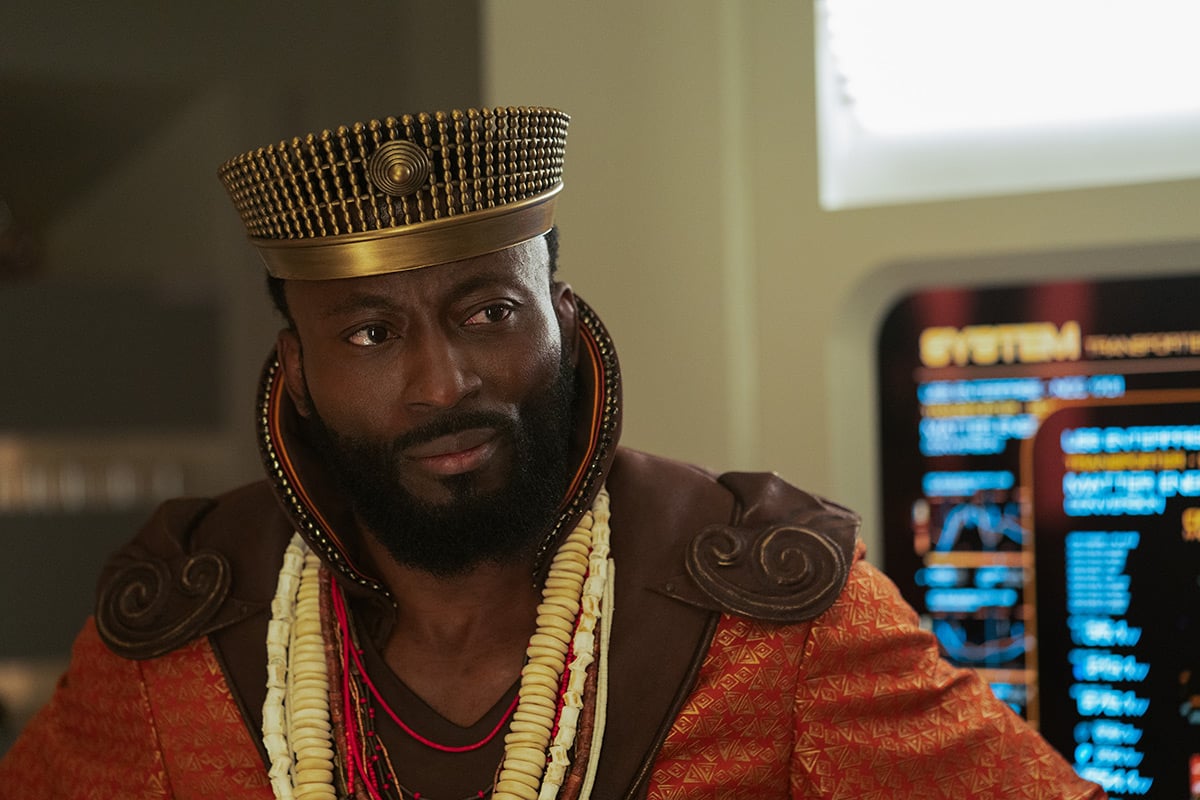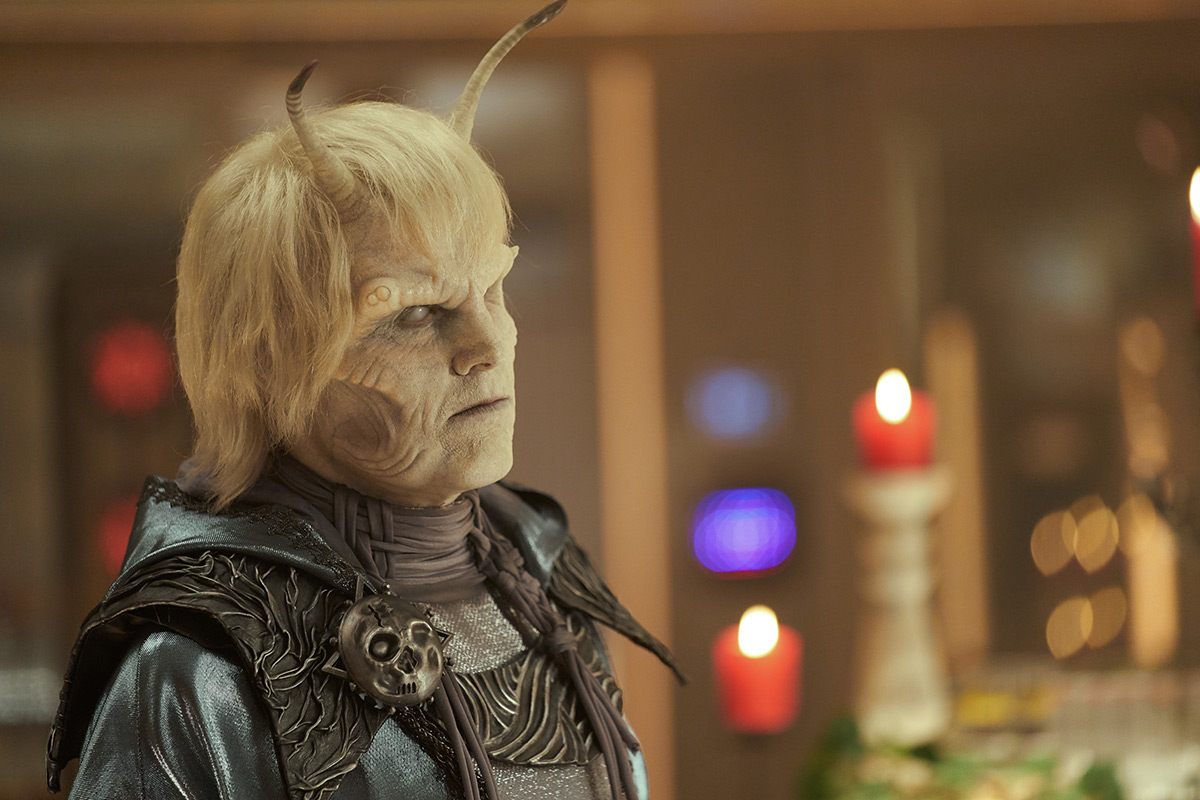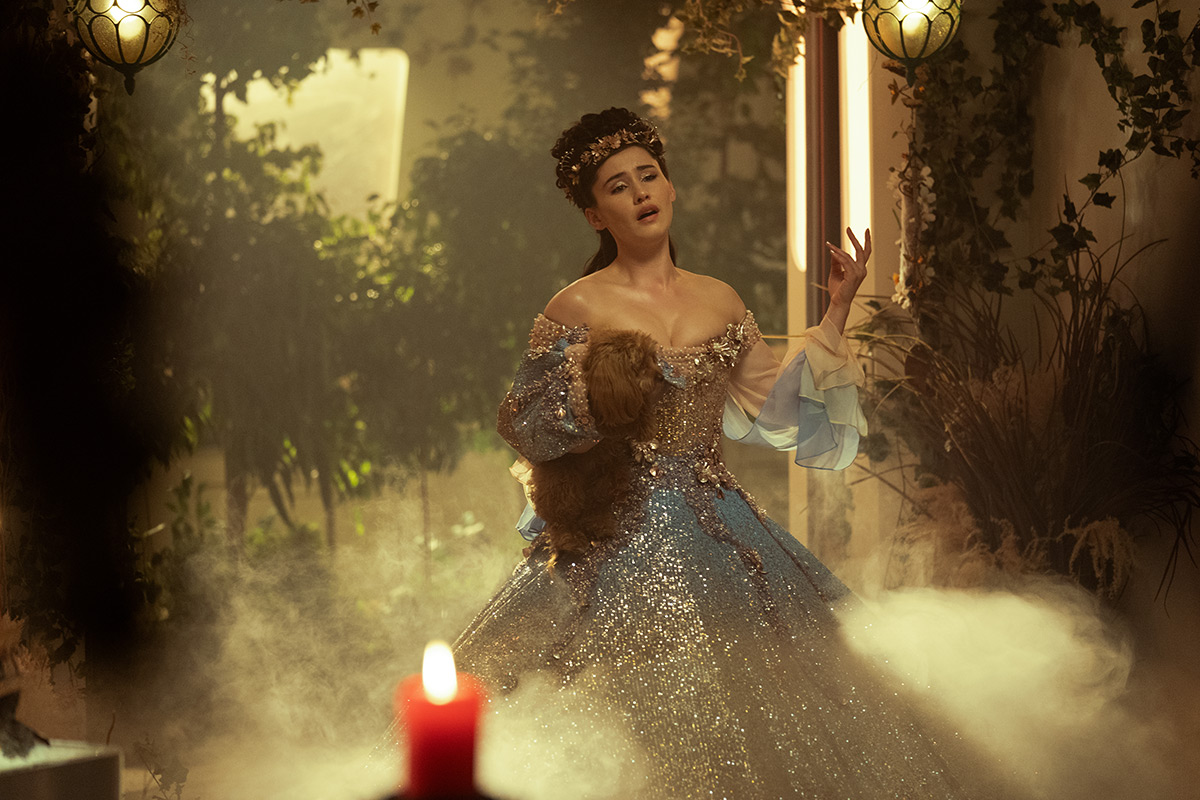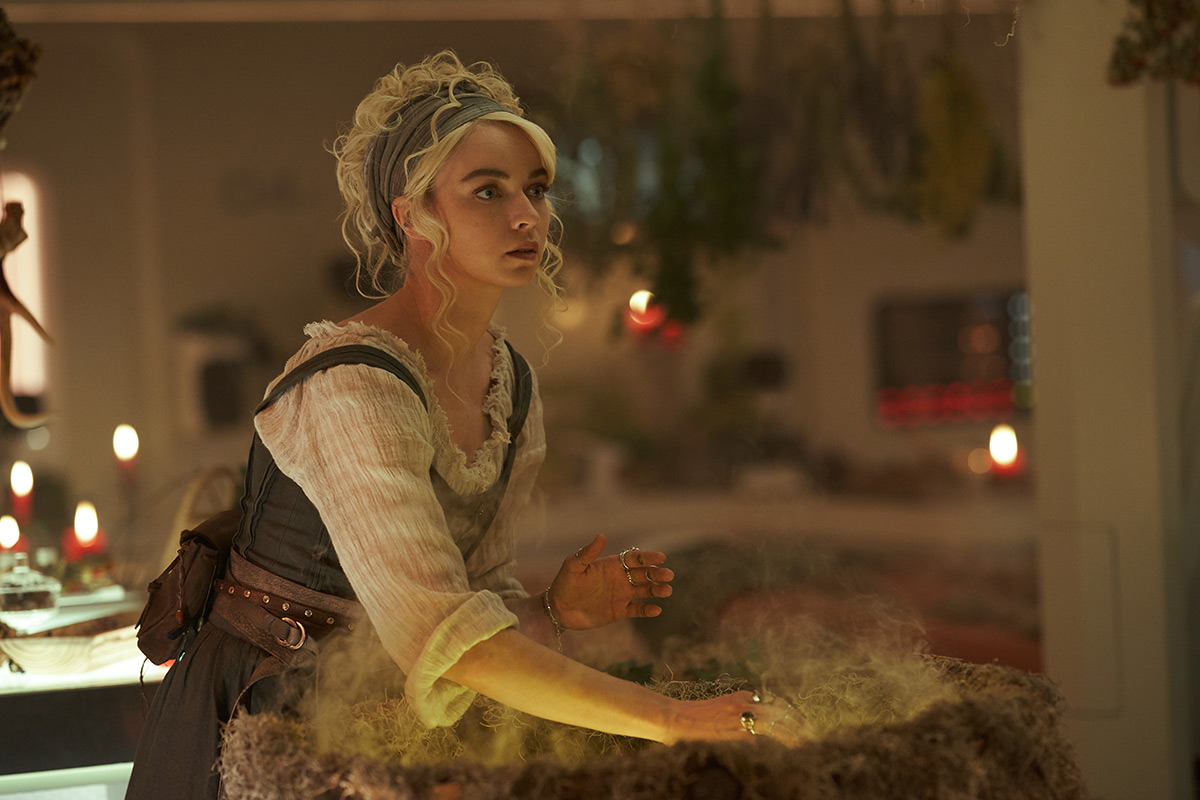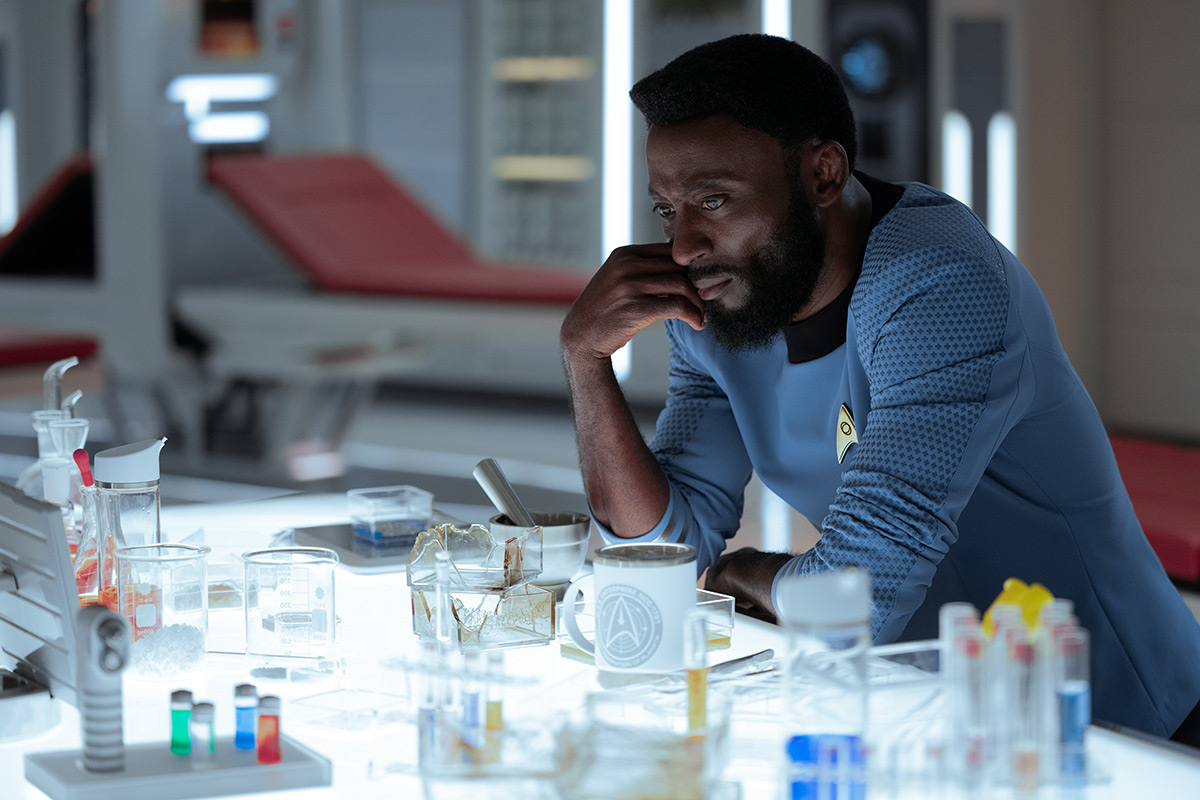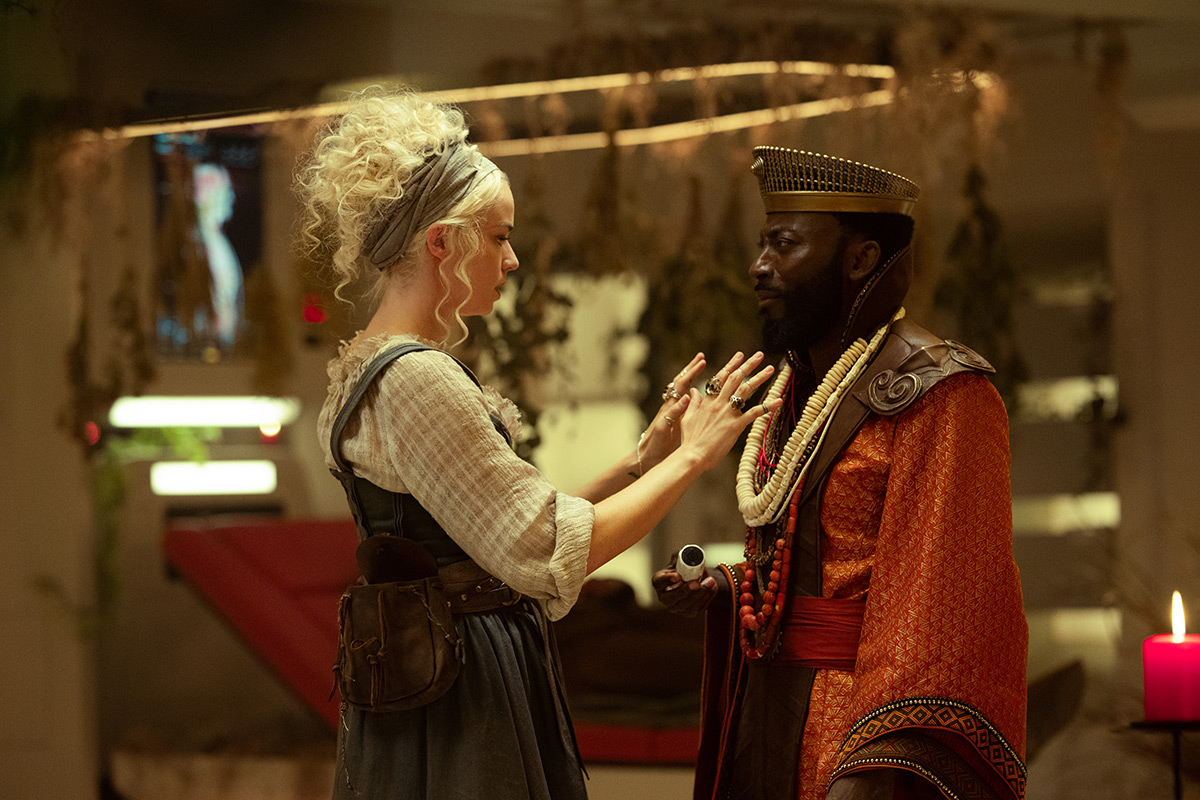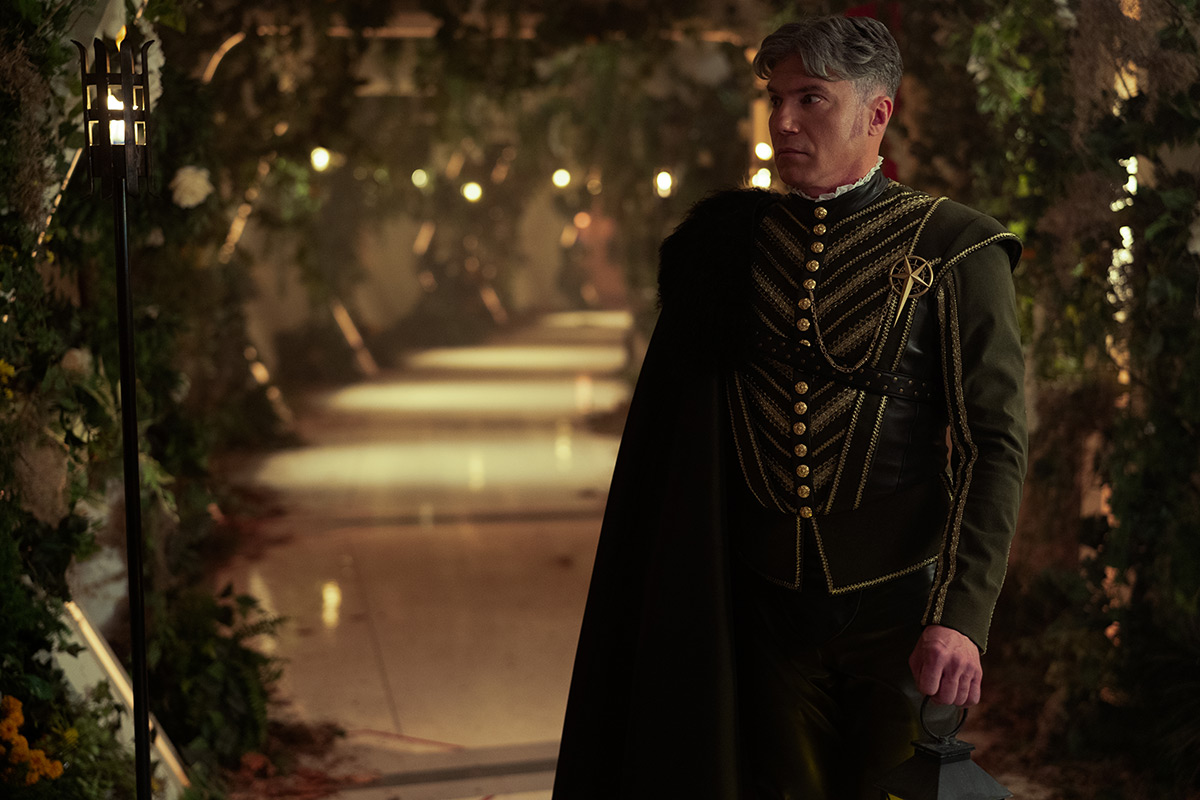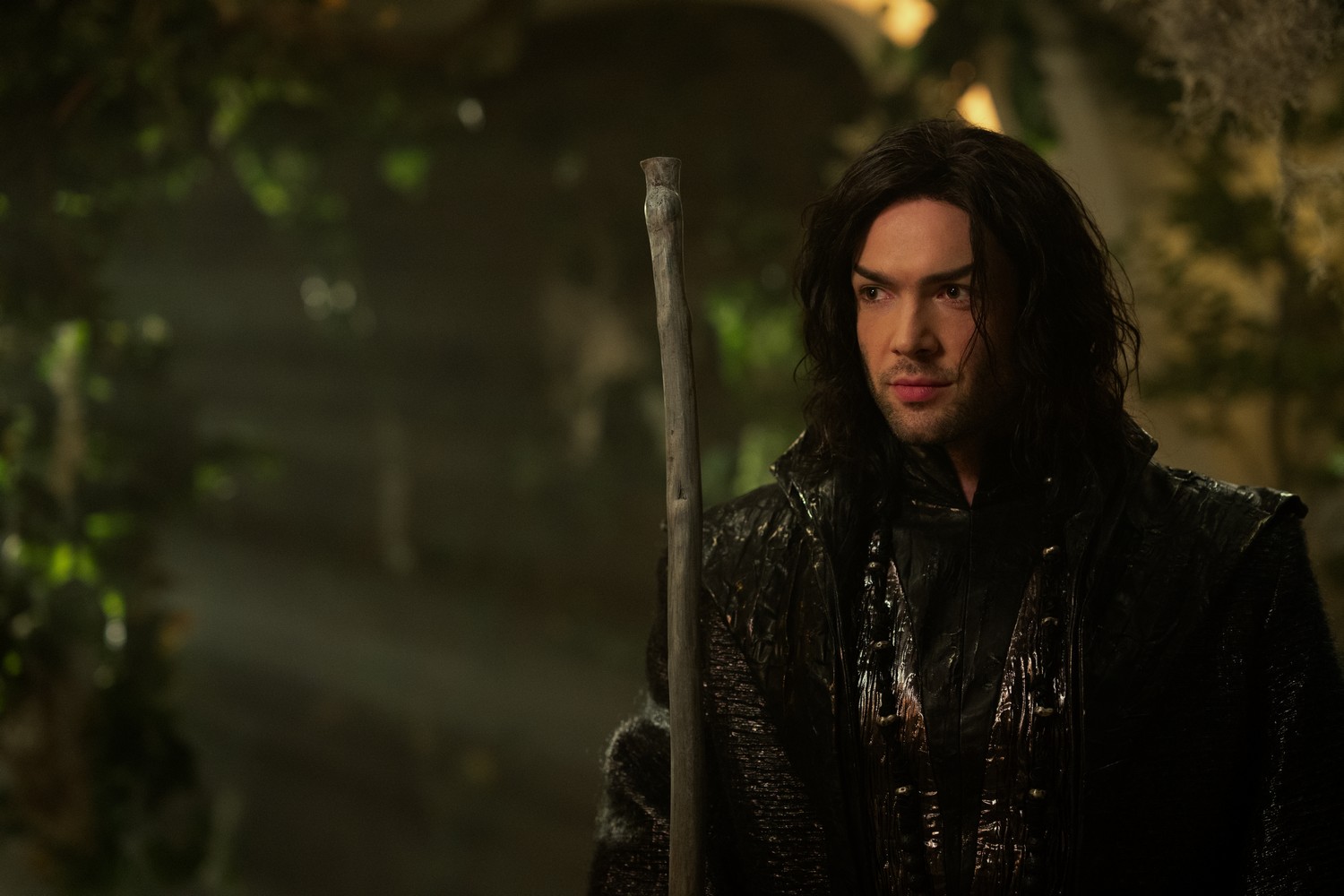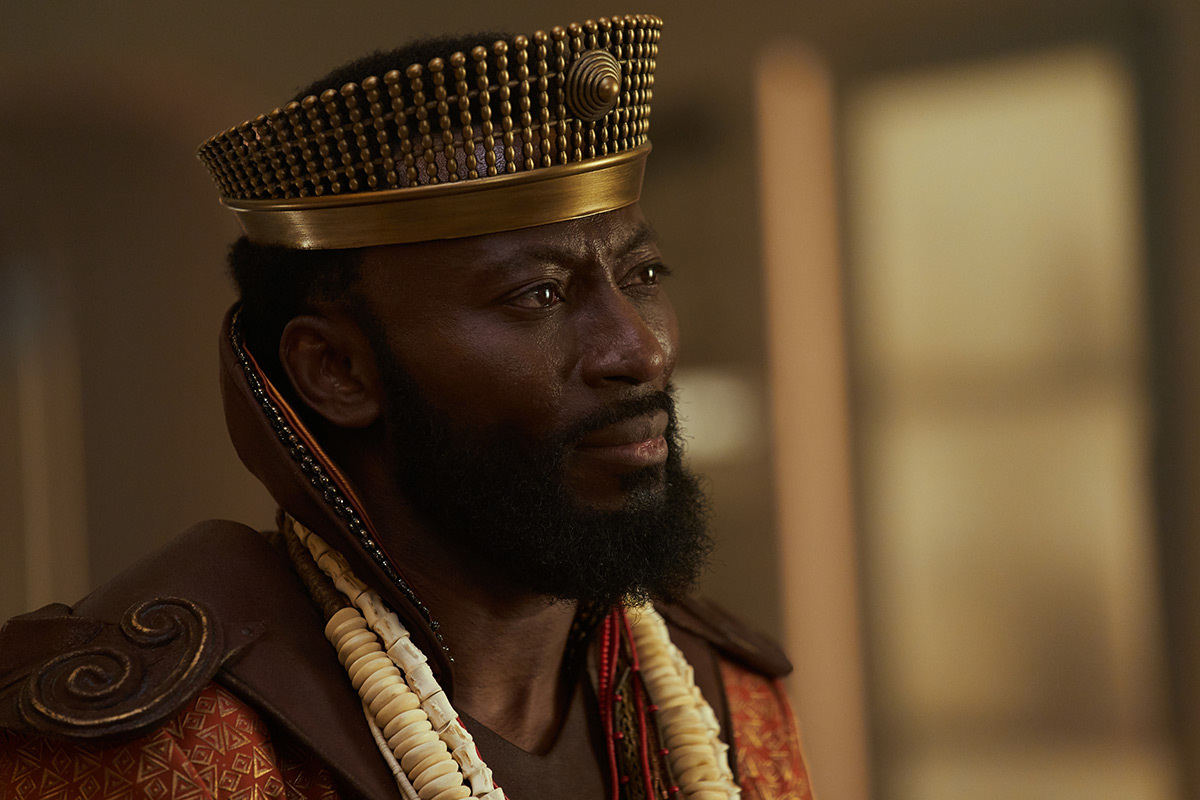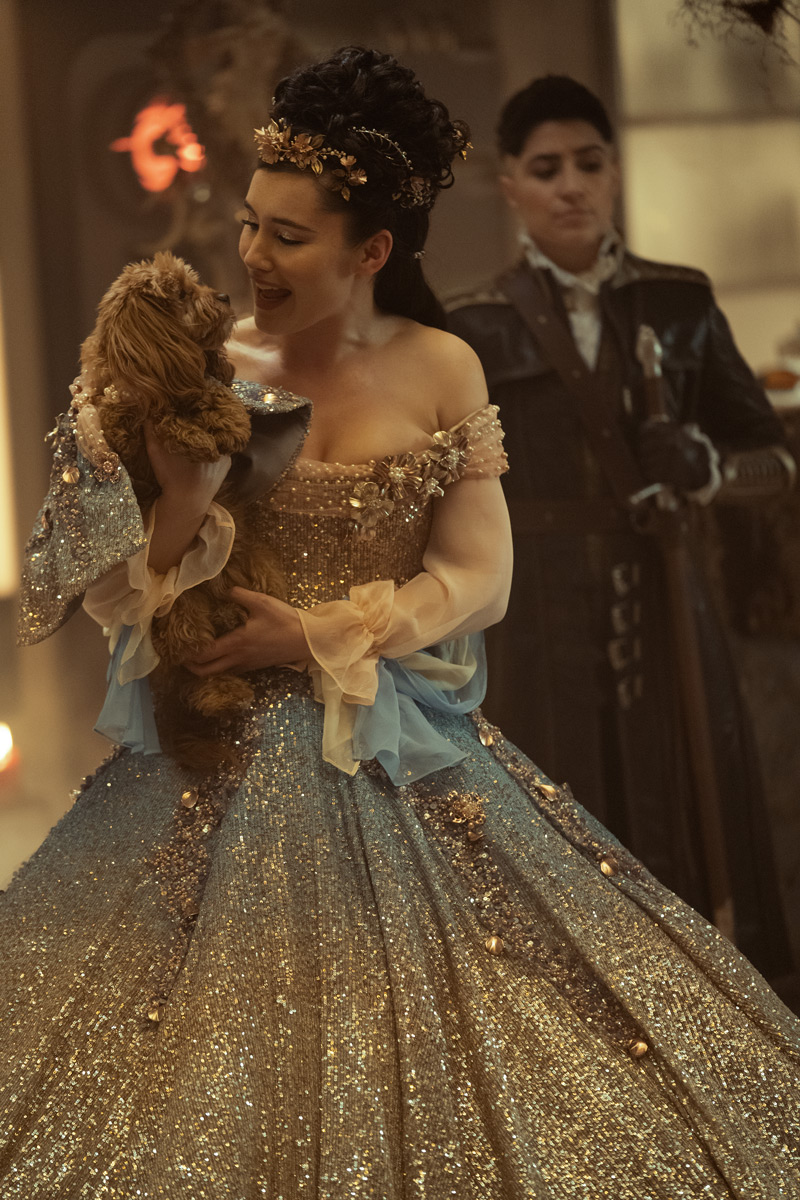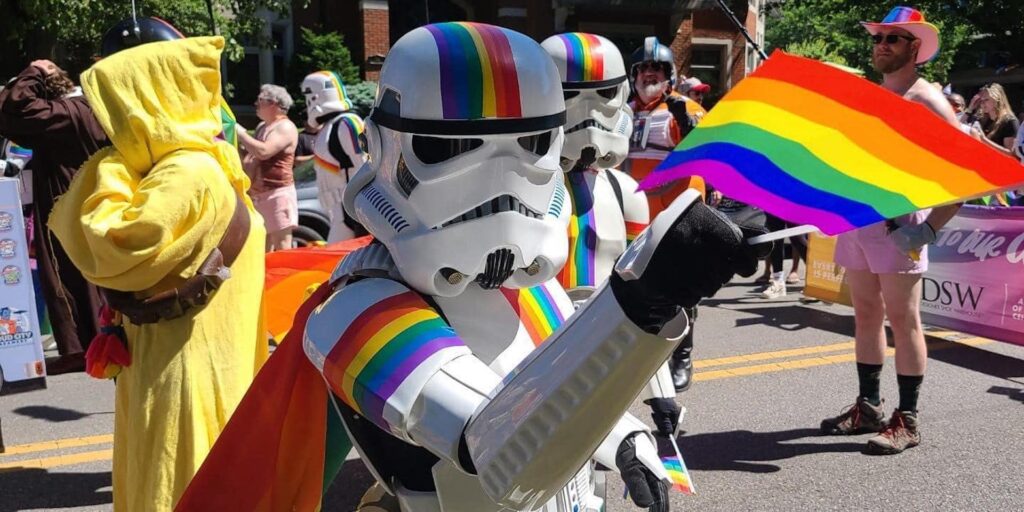‘Strange New Worlds’ “The Elysian Kingdom” is a Fairy Tale that Comes Short of Happily Ever After
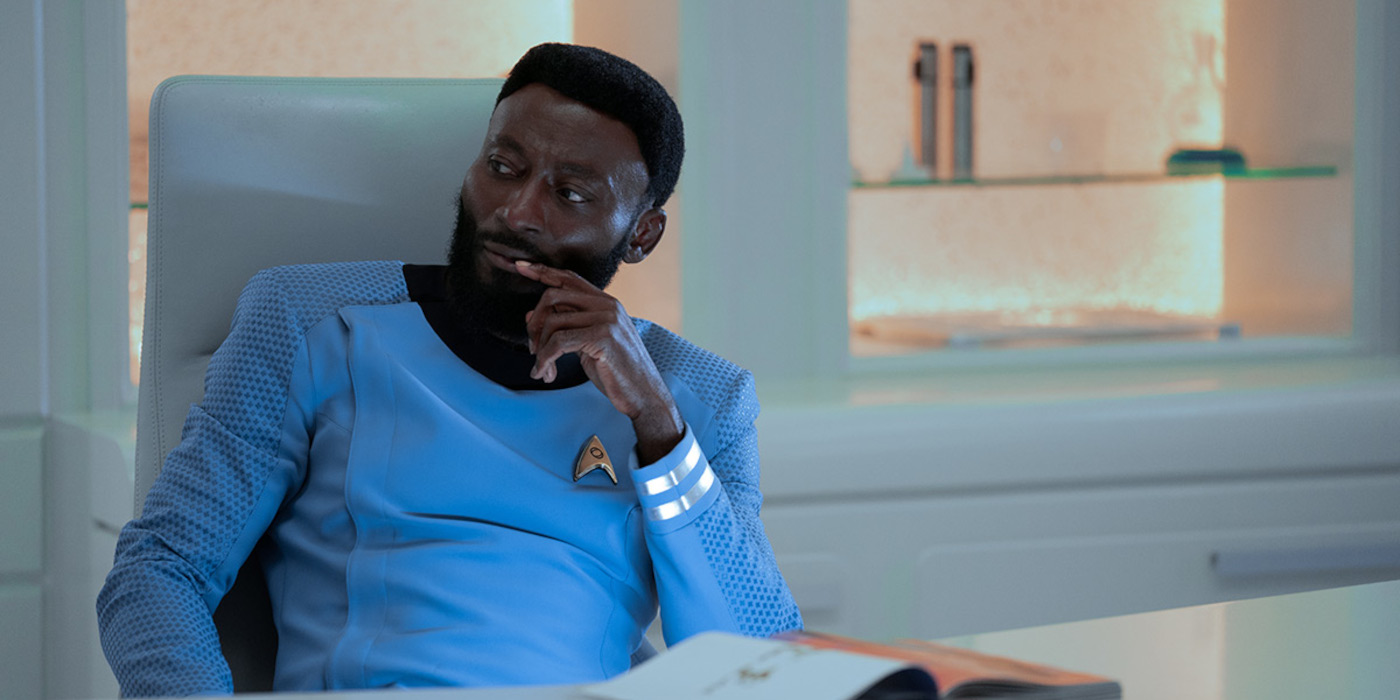
The Enterprise turns into a fantasy realm with wizards, knights, and Dr. M’Benga as its reluctant king in the “The Elysian Kingdom”
On Star Trek: Strange New Worlds, the Enterprise crew defeats all sorts of foes. Space pirates, Gorn, and even comets in space lose to Pike and company. “The Elysian Kingdom” is different because the immediate enemy is one another. And the antagonist behind it all is less sinister and more complex.
To Boldly Recap
Whenever Dr. M’Benga pulls his daughter out of the transporter buffer, he reads her the same story: “The King of Elysian”. Rukiya, as we know from previous episodes, it dying of a rare disease. But Rukiya is still a child and she thinks and feels like a child. Each time M’Benga reads this same fairy tale Rukiya wishes the story could be different. M’Benga promises, that, when he cures her, Rukiya can tell her own stories.
The Enterprise is surveying the Jonisian nebula. What could go wrong?! Answer: when they attempt to leave, the ship buckles and Ortegas is injured. When M’Benga arrives to assist, the bridge transforms into a medieval castle… almost. Basically, the Enterprise looks like the Enterprise except it has a fairy-tale fantasy skin overlay. M’Benga arrives dressed as a king and everyone else looks like “loyal” subjects. In fact, no one seems to know who they actually are.
The Enterprise crew does not look like any fantasy world, they looks like the characters from “The King of Elysia”. Ortegas is Sir Adya the knight and Pike is Sir Roth, a cowardly chamberlain. M’Benga, unable to ascertain what is going on via the computer, heads to the medical bay. There, we encounter Chapel who appears to be some kind of soothsayer/healer and La’an who is an adorable princess. La’an has a puppy also dressed like a princess. M’Benga scans both to reveal they have abnormally high dopamine levels.
In the distance, M’Benga hears the voice of the only other person not effected by whatever is happening: Hemmer.
Abracadabra is My Science Word
Hemmer, dressed as a wizard, is being dragged away by the Crimson Guard led by the evil Queen Neve. M’Benga and company are unable to rescue Hemmer, but chase after him with the help of another wizard named Pollocks aka Spock. Unfortunately, Pollocks leads them to Queen Neve (Uhura) because he is, gasp, a traitor!
Eventually, M’Benga and Hemmer find themselves together albeit behind bars. Hemmer reveals to M’Benga that, prior to the changes to the ship, he felt a foreign mind attempt to control him psychically. The party escapes with the help of Hemmer’s science (which he calls magic). After meeting up with the Huntress of the forest (Una), the team makes their way to engineering. Hemmer confirms that the entity controlling the ship exists inside the nebula but has no physical body.
At first, Hemmer believes this god-like being is reading M’Benga’s thoughts. However, realizing that the story is changed from the book, M’Benga realizes something else is going on. Adya and the Huntress are romantically connected, something Rukiya wished for. M’Benga realizes the entity is reading Rukiya’s mind. However, Rukiya is not in the pattern buffer.
Your Princess is in Another Castle
M’Benga realizes Rukiya must be in his quarters because she often wishes she could visit them. However, on the way there, M’Benga encounters Roth who also is a traitor! Thankfully, Hemmer is able to waylay Roth, Queen Neve and the Crimson Guard by transported them to a cargo bay.
M’Benga enters his quarters and finds Rukiya healed by the nebula entity. However, there is a catch – if the ship leaves the nebula, Rukiya will be sick again. M’Benga speaks to the entity through Hemmer who acts as a conduit. The entity offers Rukiya the chance to leave her body and join the entity in the nebula where she will be safe forever. M’Benga reluctantly agrees to let Rukiya leave her body and him. She vanishes.
Moments later, an adult woman appears to M’Benga – it is Rukiya. While only moments pass for M’Benga, it has been years for Rukiya. She is an adventurer and a storyteller. She tells M’Benga she named the entity Deborah after M’Benga’s (presumably dead) wife. Rukiya tells her father he made the right choice. She says they will meet again one day and begs M’Benga to be happy. The ship returns to normal and only M’Benga remembers what happened.
To Boldly Review
“The Elysian Kingdom” has compromise written all over it. It is, in almost all respects but one, a wonderful story. So let’s focus on all the things that make this episode great first.
Star Trek: The Original Series did not have much in the way of a budget. As a result, the show often relied upon sets and costumes of other shows and movies. If you’ve seen the original Star Trek, you know doubt noticed all the fantasy episodes, the gangster episodes, and other stories clearly set on the back lots of different shows and films to save money. “The Elysian Kingdom” is a bottle episode, but it is not cheap. The redressed sets look gorgeous and the costume department went all out on the medieval garb.
And more than anything, the cast clearly revels in playing against type. Anson Mount delights in playing a sniveling coward. Christina Chong revels in being a fairytale princess. Melissa Navia thrills at being the heroic knight. An Celia Rose Gooding chews the scenery with panache as the wicked queen. Everyone is having the time of their lives. And that includes Bruce Horak and Babs Olusanmokun as they react to everyone acting like lunatics. The entire experience is a laugh-out-loud joy.
Rukiya and the Entity
If everything I wrote sounds like there’s a “but” coming, that is because there is – and it is hard to talk about it. Out of eight episodes, three are dedicated to M’Benga’s efforts to save his daughter Rukiya. In “Lift Us Where Suffering Cannot Reach” we even see M’Benga gain new science that may help Ruikya survive her terminal illness. And then, in “The Elysian Kingdom” this story ends abruptly, essentially taking the narrative built thus far and throwing it in the trash. Put simply, this ending does not make sense for the characters or the long-form story and I struggle to understand why this is how Rukiya’s tale seems to end.
Why does M’Benga believe that a god-like entity he has just met has Rukiya’s best interests at heart? Deborah, as she is ultimately named, controls the minds of the entire crew without consent. At any time, the crew could die at Deborah’s hands yet M’Benga trusts her with his daughter’s life. M’Benga is on the way to finding a cure for his daughter and yet he lets her go without any proof she will actually survive the transition from physically body to intergalactic nebula being.
Writing a child out of a narrative by making them magically an adult is a tired trope that seldom serves character or narrative and “The Elysian Kingdom” is no exception. Rukiya is the tie that binds us to M’Benga. She is his heart and soul. And now she is gone. It is hard not to view that as a loss and a misstep. We need to talk about the complexity of this.
Episode Writers vs. Showrunners
“The Elysian Kingdom” is written by Akela Cooper and Onitra Johnson. I want to be very clear that they do a wonderful job. We cannot say for certain, but, if you know anything about television writing, it is often the showrunners who decide story structure. I believe that Cooper and Johnson were told going in how Rukiya’s story would end. And I believe they did the best version of that ending possible.
Rukiya decides her own destiny. She chooses to live. And that is powerful, no doubt about that. In our real world where Black women so rarely get the choice to write their own joyous stories, I am sincerely glad that Rukiya gets to write hers. But what I want is for her to stay with her father, to be a child with him, and for Star Trek to tell stories of a Black father raising his daughter with love and safety.
The last time we saw an ongoing story focused on a Black father raising his child was with Benjamin Sisko on Star Trek: Deep Space Nine. It was a big deal then and it is just as rare and necessary now. So for me, the ending of “The Elysian Kingdom” goes beyond not quite making sense, it deprives us of a story and a relationship we need. And that makes me sad and frustrated even though I see and am grateful for how beautiful and touching the performance between Babs Olusanmokun and Sage Arrindell are.
Also, did they nonchalantly reveal that M’Benga’s wife is dead? I hope not, but I’m not sure there’s another read for Rukiya naming the entity after her mother in this context. The episode is beautiful otherwise, but the ending is a tough pill to swallow.
Stray Observation Deck
This cannot be overstated: find someone who loves you the way Anson Mount loves to play a sniveling coward. Related: find someone who loves you the way Hemmer loves treating science like it’s magic.
While Una and Ortegas are not themselves in “The Elysian Kingdom” this appears to be the first time their status as queer people is acknowledged.
La’an sings a very weird, bad song and that is clearly a callback to “Children of the Comet” where she says that her singing voice would shatter glass. Accurate.
Related: La’an’s princess puppy is, in fact, Christina Chong’s real life dog Runa. Did Runa get to keep her costume? The world may never know.
Hemmer hypothesizes that the bodiless entity in the nebula is a “Boltzmann brain” which is a real philosophical concept first suggested by Ludwig Boltzmann.
The MVP Award
We’ve never done this, but a huge standing ovation has to be given to costume designer Bernadette Croft and her team. “The Elysian Kingdom” is a massive undertaking and an unfathomable costuming challenge. Every character gets their own elaborate costume pieces which cannot be shopped for. In other words: those folks crafted hand-made garments and accessories in a very short time and they made a herculean task look effortless.
You know what? We have time. Jennifer M. Johnson, key fx costumer: thank you. Karen Lee, costume supervisor: thank you. Beverly Law, textile artist/fx builder: thank you. Alexander Silberberg, key fx costumer /key fx sculptor: thank you. Sarah Alfred and Heather Campbell, textile artists: thank you. Gillian ‘Fidge’ Fletcher, wardrobe: thank you. Sue Furlong, first cutter: thank you. Trish Murray, background costume coordinator, thank you. Anna Pantcheva, Key Textile Artist, thank you. Merv Perez and Sylvia Petiquan, fx costumers: thank you.
Star Trek: Strange New Worlds does not happen without these people. I hope they know how deeply grateful we are for their work. If you’re seeing this, take a bow, folks. You earn your flowers on this show every week, but you earned them a thousand fold for “The Elysian Kingdom”.
Questions, Queries, Quibbles
Obviously, the biggest question is that of Rukiya’s future? Will we actually see her again? If so, what will the context for that meeting be? And, more importantly, who is M’Benga without his daughter? How much will we see him struggle and evolve as he learns to live without Rukiya? With only two episodes left, there’s a lot still to cover with the first season of Star Trek: Strange New Worlds. In next week’s episode, something stirs in the icy darkness of a cold, empty world.
What happens next? Tell us your theorizes in the comments.
Until next time, this is your humble recapper signing off. Live long and prosper!

